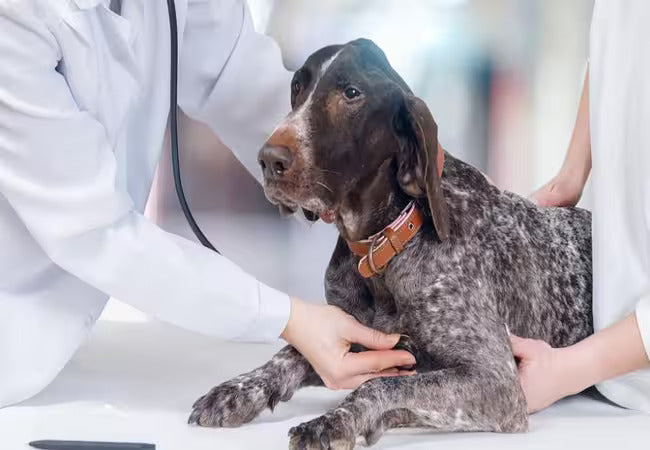Veterinary Guide to Canine Testicular Tumors 2025: Diagnosis, Treatment & Prevention 🐕⚕️

In this article
Veterinary Guide to Canine Testicular Tumors 2025: Diagnosis, Treatment & Prevention 🐕⚕️
By Dr. Duncan Houston BVSc
🧠 Overview
Testicular tumors are the most common reproductive tumors in unneutered male dogs, especially older or cryptorchid (undescended testicle) pets. In 2025, veterinary care has improved with advanced ultrasound imaging and a focus on prevention through early castration and cryptorchid management.
🏷️ Tumor Types & Risk Factors
- Seminomas: Arise from germ cells; usually slow-growing.
- Interstitial (Leydig) cell tumors: From testosterone-producing cells—typically benign.
- Sertoli cell tumors: Nourishing cell origin; often estrogen-secreting with systemic signs.
- Mixed tumors: Contain multiple cell types; occur in ~7% of cases.
- Other rare tumors: Lipomas, fibromas, hemangiomas.
Risk factors: Untested intact males, cryptorchidism (up to 13.6× higher cancer risk) , and breeds like German Shepherd, Boxer, Collie, Afghan Hound, Weimaraner, Sheltie, Maltese, and Siberian Husky.
🔎 Signs & Symptoms
- Swollen, firm, or asymmetrical testicle(s).
- Scrotal enlargement, irregular lumps.
- Sertoli tumors: Feminization (enlarged mammary glands, hair loss, pendulous prepuce, anemia).
- Advanced/metastatic cases: Weight loss, cough, lethargy, difficulty urinating/defecating.
📋 Diagnosis
- Physical exam: Scrotal palpation often reveals nodules.
- Ultrasound: B-mode, color Doppler, elastography distinguish tumor types and cryptorchid location.
- X-rays/CT: Check for metastasis to lungs or lymph nodes.
- Blood tests: Evaluate systemic effects like estrogen-driven anemia.
- Histopathology: After orchiectomy or biopsy confirms tumor type.
💉 Treatment Options
1. Surgical Removal (Orchiectomy)
Complete surgical sterilization is curative in most cases. In cryptorchids, both normal and retained testicles are removed.
2. Additional Therapy
- Metastatic or aggressive tumors may require chemotherapy or radiation, though efficacy is mixed.
- Sertoli tumors with estrogen effects: Supplementation and long recovery (2–6 weeks for feminization to resolve).
✔️ Post-Surgical Care & Recovery
- Soft activity, E-collar, 10–14 days rest.
- Monitor incision for swelling, discharge, redness.
- Follow-up physical exam; chest X-ray if concerned about spread.
- Systemic signs (anemia, feminization) resolve post surgery within weeks—monitor bloodwork.
📈 Prognosis
- Seminomas & Leydig tumors have excellent prognosis after removal.
- Sertoli tumors have good prognosis if not metastatic; monitor hormonal effects.
- Mixed tumors: Prognosis depends on components and spread.
- Overall cure rate >80%, with only 10–20% having metastasis at diagnosis.
🛡️ Prevention Strategies
- Early neutering: Before 6–15 months dramatically reduces risk.
- Cryptorchid dogs: Avoid breeding; schedule removal of both testicles early.
- Regular scrotal exams: Enables early tumor detection.
- Breed awareness: Owners of at-risk breeds (e.g., Shepherds, Boxers, Collies) should have proactive vet checks.
🏥 What’s New in 2025 Care
- Advanced ultrasound technology (elastography, color Doppler—see images) improves early tumor characterization.
- Minimally invasive laparoscopic cryptorchid neuter reduces recovery time.
- Post-surgery telehealth monitoring by Ask A Vet ensures early identification of complications.
- Refined anesthesia & pain protocols enhance senior dog safety.
👨⚕️ Role of Ask A Vet
- Ask A Vet: 24/7 vet access for assessing testicular changes, deciding on neutering, arranging diagnostics, and guiding fast post-op recovery.
📝 Final Thoughts from Dr Duncan
Testicular tumors in dogs are common but highly treatable, especially when identified early. Neutering remains the cornerstone of prevention, and prompt removal cures most cases. 2025 offers excellent tools—from advanced imaging to telehealth—for better dog health outcomes. If you notice anything unusual, consult your vet or ask via Ask A Vet. Together, we can ensure your male companion stays thriving and tumor-free. 💙
Visit AskAVet.com or download the Ask A Vet app for expert vet support on tumor removal, post-op care, or health monitoring.






